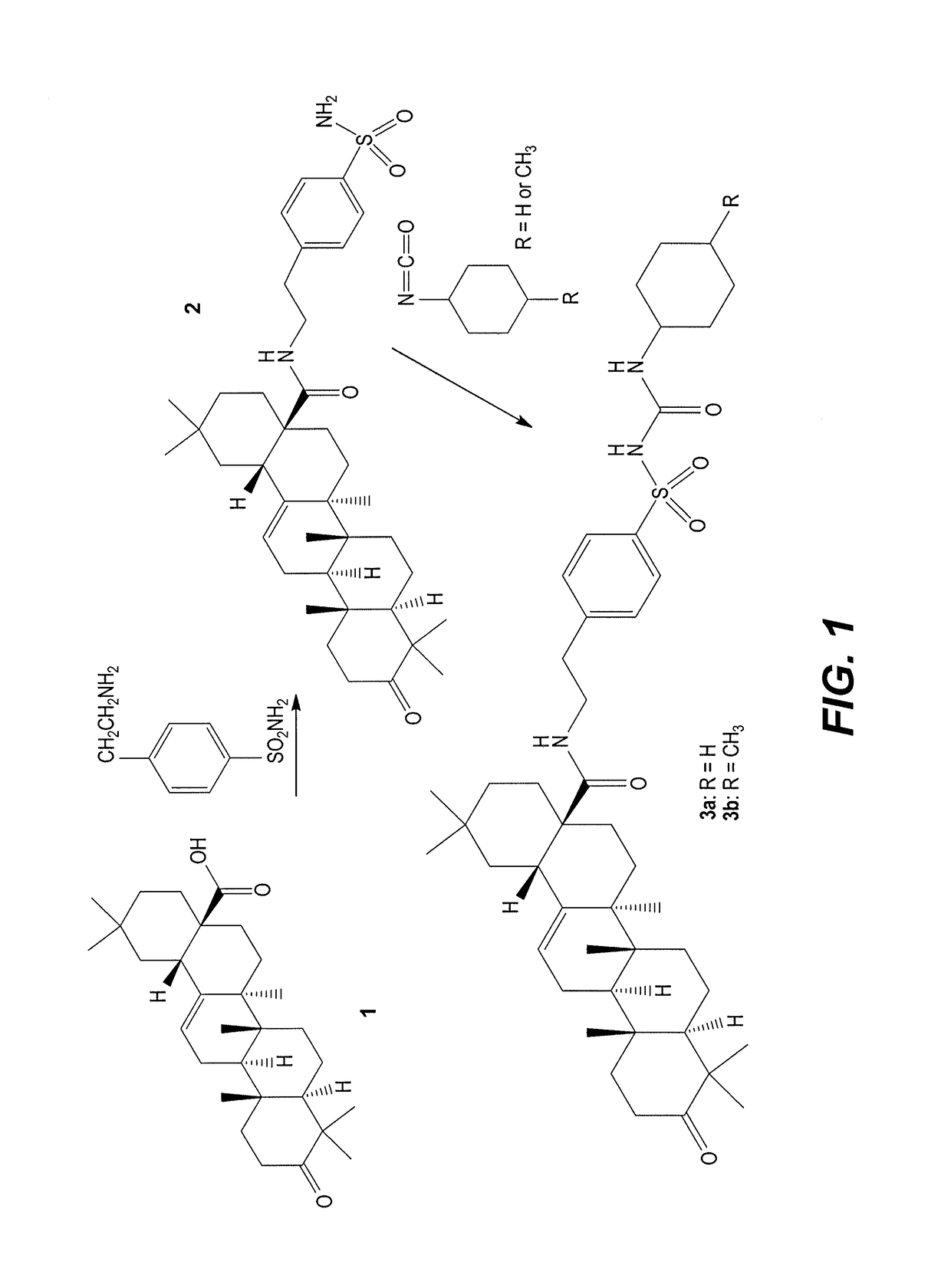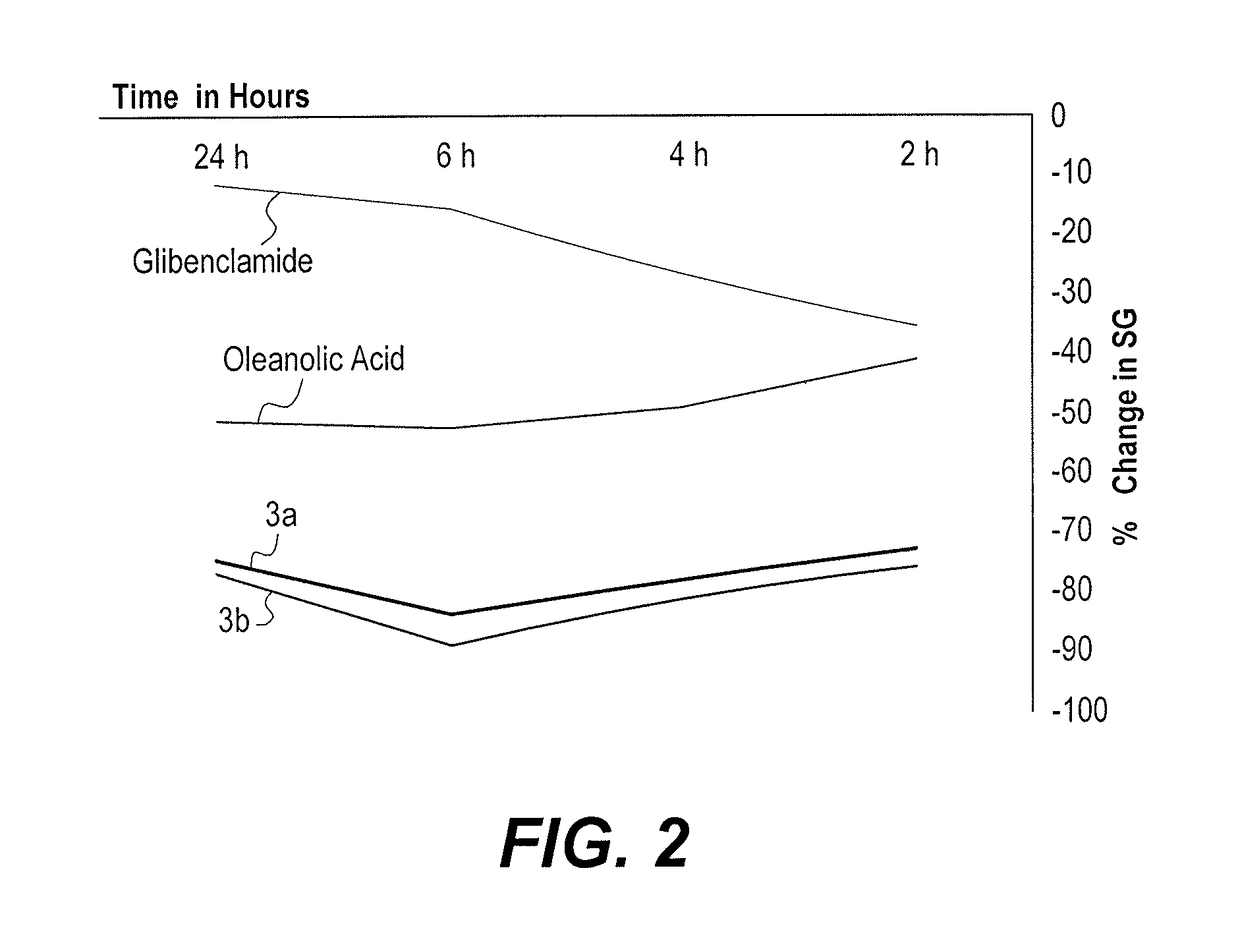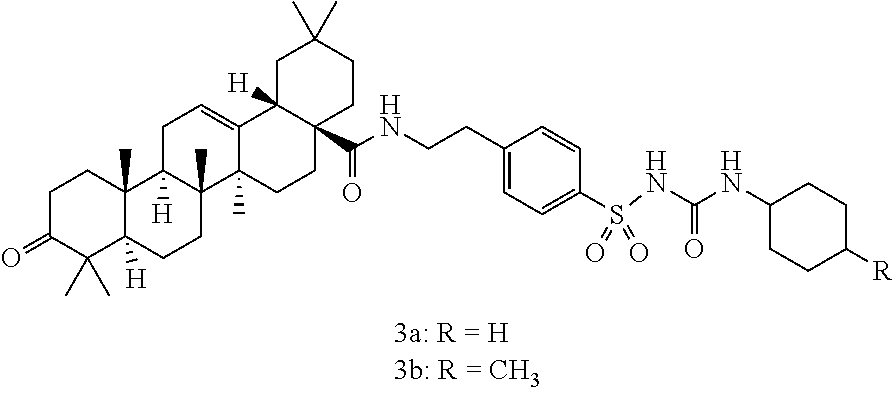Sulfonylurea derivatives of oleanolic acid
- Summary
- Abstract
- Description
- Claims
- Application Information
AI Technical Summary
Benefits of technology
Problems solved by technology
Method used
Image
Examples
example 1
Synthesis of Sulfonylurea Derivatives of Oleanolic Acid—General Reaction
[0013]An exemplary reaction scheme for preparing the sulfonylurea derivatives of oleanolic acid is shown in FIG. 1. Briefly, N-[(p-ethyl)-benzene-sulfonamide]-3-oxo-18β-olean-12-ene-28-carboxamide (2) is prepared by condensing 3-oxo-Olean-12-en-28-oic acid (1), also referred to a 3-oxo-oleanolic acid, with 4-(2-aminoethyl)benzenesulfonamide using the mixed anhydride technique adopted for the preparation of amides using trifluoroaceticanhydride. Compound 2 is then reacted with cyclohexyl isocyanate or 4-methylcyclohexyl isocyanate to produce the sulfonylurea derivatives 3a and 3b, respectively.
example 2
Synthesis of Intermediate
[0014]In more detail, the intermediate compound, N-[(4-ethyl)-benzenesulfonamide]-3-oxo-18β-olean-12-ene-28-carboxamide (2), was synthesized as follows. Trifluoroaceticanhydride (4 mmol) was added dropwise to a solution of compound 1 (4 mmol) in dioxane (100 ml) at 0-5° C. The resulting mixture was reacted for 1.5 hr, then 4-(2-amino-ethyl)benzenesulfonamide (4 mmol) was added, and the resulting mixture was stored without stirring overnight. The reaction mixture was then evaporated under reduced pressure to dryness and the resulting solid product was crystallized from ethyl acetate / methanol to give compound 2. Yield 90%, mp. 287-289° C., [α]D25=+112 (c 1, CHCl3); IR (KBr): 3551-3410 (NH2, NH), 3050 (CH—Ar), 2931 (CH-aliph), 1748 (C═O), 1335 (S═O) cm−1. 1H NMR (pyridine-d5): δ ppm 0.83 (d, 1H, CH), 0.89 (s, 3H, CH3), 0.93 (s, 3H, CH3), 0.98 (s, 3H, CH3), 1.02 (d, 1H, CH), 1.06 (s, 3H, CH3), 1.11 (s, 3H, CH3), 1.18-1.27 (m, 8H, 2CH and 2CH3), 1.37-1.70 (m, 7H,...
example 3
Synthesis of Final Product
[0015]In more detail, the final products, N1-[4-(3-oxo-18β-olean-12-ene-28-amido-ethyl)benzenesulfonyl]-N2-cyclohexylurea derivatives (3a,3b) were synthesized as follows. Unsubstituted or substituted cyclohexyl isocyanates, namely, cyclohexyl isocyanate or 4-methylcyclohexyl isocyanate (1.1 mmol), were added dropwise to a solution of compound 2 (1 mmol) in sodium hydroxide (8 ml, 10%) and acetone (20 ml) at 0-5° C. The resulting reaction mixture was kept at the same temperature for 3 hr, diluted with a water / methanol mixture (1:1), and then filtered off. The resulting filtrate was acidified with HCl, and a separated solid was filtered off, dried and recrystallized from acetic acid to yield sulfonylurea derivative compounds 3a or 3b, as follows.
[0016]N1-[p-(4-Oxo-18β-olean-12-ene-28-amido-ethyl)-benzenesulfonyl]-N2-cyclohexyl-urea (3a): Yield 81%, mp. 327° C., [α]D25=+123 (c 1, CHCl3); IR (KBr): 3511-3386 (2NH), 3052 (CH—Ar), 2922 (CH-aliph), 1746 (C═O), 169...
PUM
 Login to View More
Login to View More Abstract
Description
Claims
Application Information
 Login to View More
Login to View More - R&D
- Intellectual Property
- Life Sciences
- Materials
- Tech Scout
- Unparalleled Data Quality
- Higher Quality Content
- 60% Fewer Hallucinations
Browse by: Latest US Patents, China's latest patents, Technical Efficacy Thesaurus, Application Domain, Technology Topic, Popular Technical Reports.
© 2025 PatSnap. All rights reserved.Legal|Privacy policy|Modern Slavery Act Transparency Statement|Sitemap|About US| Contact US: help@patsnap.com



